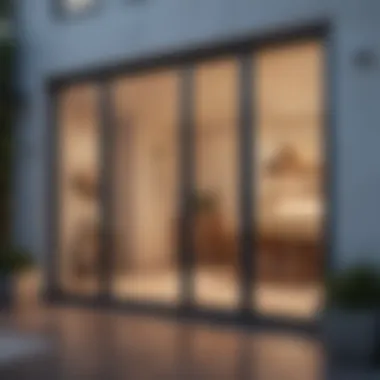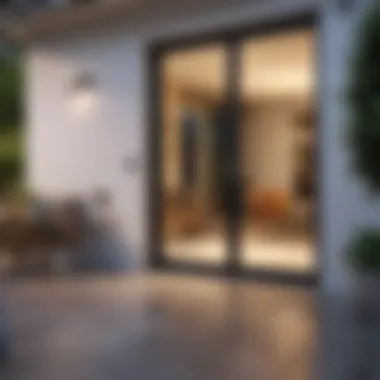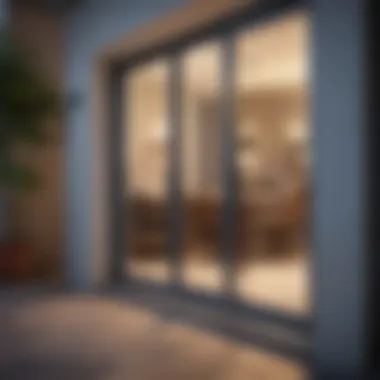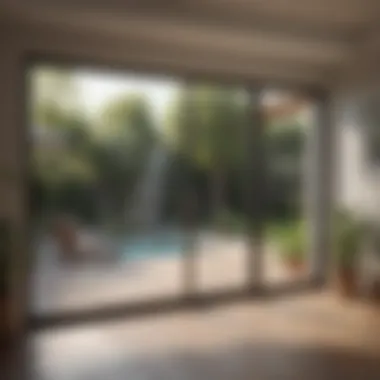Understanding the Costs of Patio Doors: A Comprehensive Guide


Intro
When considering the enhancement of a home, patio doors often emerge as a compelling choice. They provide a gateway to outdoor spaces while allowing natural light to fill the interior. Understanding the costs associated with patio doors is essential for homeowners looking to make informed decisions. From the materials selected to the styles chosen and the expenses associated with installation, each factor plays a significant role.
This guide aims to illuminate various components influencing patio door costs. Homeowners can benefit from grasping the intricacies of their options. Whether a project is centered around functionality, aesthetics, or both, the choices made can have lasting implications on both immediate budgeting and long-term value.
In this exploration, we will dissect key elements including design inspirations that appeal to current trends, the importance of maintenance, and how different materials affect pricing. By understanding these factors, homeowners and design enthusiasts alike can better navigate their choices in patio doors.
Prolusion to Patio Door Costs
The decision to install patio doors involves various considerations that extend far beyond aesthetics. Understanding the costs associated with patio doors is crucial for homeowners and enthusiasts. This section elucidates key aspects to aid in effective decision-making.
Overview of Patio Doors
Patio doors serve a significant role in enhancing both the functionality and aesthetic appeal of a home. They allow natural light into living spaces and provide easy access to outdoor areas, such as decks and gardens. The most common types include sliding, French, and bi-fold doors, each offering unique benefits. Sliding doors maximize space efficiency, while French doors provide a classic charm. Bi-fold doors create a seamless transition between indoor and outdoor spaces. However, understanding the various styles is only part of the equation. Costs can vary greatly depending on design, materials, and installation methods.
Importance of Understanding Costs
Awareness of patio door costs is essential for several reasons. First, it ensures proper budget allocation. Homeowners often underestimate total expenses if they focus solely on the initial price. Beyond the purchase price, additional costs include installation, materials, and potential maintenance fees.
Moreover, understanding costs helps in evaluating long-term savings. Energy-efficient patio doors might require a higher upfront investment but can lead to lower utility bills over time. Therefore, having a comprehensive grasp of the financial implications allows for informed choices that align with both immediate needs and future goals.
"Knowledge of costs is not just about spending wisely, but investing in long-term benefits."
Types of Patio Doors
Understanding the various types of patio doors is essential for homeowners and design enthusiasts alike. Each type presents unique benefits and considerations that can significantly influence both aesthetic choices and budget constraints. Selecting the correct style not only impacts the overall appearance of the home but also affects functionality, energy efficiency, and long-term maintenance costs.
Sliding Patio Doors
Sliding patio doors offer a streamlined design that maximizes space. They are typically composed of large glass panels framed in aluminum or vinyl. This type allows for easy access while providing substantial views of the outside. One key benefit is their space-saving feature, as they don’t require clearance for swinging open.
The cost of sliding patio doors varies based on materials and features. Basic models may start around $500, while high-end options with custom features can exceed $2,500. Homeowners should consider the following:
- Energy Efficiency: Look for double or triple-pane glass options to enhance insulation.
- Security Features: Strong locks and tempered glass can add to safety.
- Aesthetics: Select frames that complement your home’s design.
French Patio Doors
French patio doors are a classic choice that elevates the elegance of any space. They typically consist of two doors that open outwards or inwards, creating a grand entrance to outdoor areas. The style often enhances traditional and contemporary homes alike.
Pricing for French patio doors ranges broadly, usually from $800 to over $3,000, depending on the material and custom options selected. Consider these elements:
- Material Choices: Wood frames may offer beauty but need more maintenance compared to vinyl or fiberglass.
- Space Requirements: Ensure there is enough space for the doors to swing open without obstruction.
- Historical Authenticity: They can be tailored to match historical architectural styles, adding value to heritage homes.
Bi-Fold Patio Doors
Bi-fold patio doors can transform a wall of your home into an expansive opening. They consist of multiple panels that fold to the side, offering an open-air feel when fully retracted. This style is particularly popular in modern designs, blurring the lines between indoor and outdoor living.
Typically, the cost for bi-fold patio doors starts around $2,000 and can escalate to $5,000 or more based on size and material. Here are some aspects to consider:
- Opening Width: Ideal for larger spaces, consider how wide you want the opening when fully extended.
- Thermal Performance: Ensure the doors are designed for insulation to maintain energy efficiency.
- Outdoor Integration: Perfect for connecting indoor spaces with patios or gardens, they enhance functionality and aesthetics.
Consideration: Choosing the right type of patio door significantly affects both the visual appeal and the practical use of your space. Evaluate all options before making a decision.
Material Choices and Their Impact on Cost


When considering patio doors, material choices emerge as a critical factor influencing overall costs. Different materials have distinct advantages and disadvantages that not only affect the purchase price but also durability, maintenance, and energy efficiency over time. Homeowners should take these considerations into account, ensuring they select a material that fits both their budget and their long-term living needs.
Vinyl Patio Doors
Vinyl patio doors are a popular option, known for their affordability and low-maintenance qualities. The cost of vinyl doors is generally lower than that of wood or aluminum alternatives. They offer decent insulation properties and can contribute to energy savings. Vinyl is also resistant to warping, fading, and cracking, which increases its longevity.
However, customization options are somewhat limited. Unlike wood, vinyl doesn’t provide the rich aesthetic that many homeowners desire. The color choices are often limited to a few standard tones, and they cannot be painted easily if a homeowner wants to change their appearance. While they are a budget-friendly option, the long-term aesthetic appeal might not satisfy everyone.
Wood Patio Doors
Wood patio doors bring a timeless appeal that many find irresistible. They provide excellent insulation and can be customized in a variety of finishes and colors. Although they come with a higher initial cost compared to vinyl, the beauty they bring to a home can readily justify the investment.
Nonetheless, the long-term costs associated with wood doors can be significant. Wood requires regular maintenance to prevent rot, warping, and insect damage, which can add up over the years. Additionally, they are more susceptible to the elements compared to vinyl. Homeowners should consider these factors when evaluating the total cost of ownership.
Aluminum Patio Doors
Aluminum patio doors are recognized for their strength and durability. They tend to be more expensive initially, yet they are less prone to warping and damage over time. The sleek, modern appearance of aluminum doors often appeals to contemporary home designs.
On the downside, aluminum is a poor insulator unless thermal breaks are incorporated into the design. This can lead to higher energy costs if the doors are not adequately insulated. Additionally, while available in various finishes, the customization options are limited when compared to wood.
"Choosing the right material for patio doors can ultimately affect your long-term financial outlay due to maintenance and energy costs."
In summary, the choice of material for patio doors significantly impacts not only the initial cost but also long-term expenses and aesthetic value. Homeowners must assess their personal preferences alongside budget constraints to determine the most suitable option.
Factors Influencing Patio Door Costs
Understanding the costs associated with patio doors involves multiple factors that significantly affect the overall price. Homeowners must consider these aspects to make informed decisions. This section explores essential elements like size and dimensions, glass types and energy efficiency, and hardware and accessories. Each factor impacts both initial spending and long-term sustainability.
Size and Dimensions
The size of the patio door is one of the foremost factors influencing cost. Larger doors require more material and can lead to higher manufacturing and installation expenses. Standard sizes might be more affordable, but if custom dimensions are needed, the price can increase markedly.
Additionally, the dimensions affect the type of door chosen. For instance, a bi-fold door necessitates more intricacy in design, compared to a sliding door. This increased complexity often correlates with a higher price tag. Homeowners should also consider the space where the door will be placed. A larger opening may require structural changes, which can further add to costs.
In summary, choosing the right size and understanding the implications is crucial for effective budget management.
Glass Types and Energy Efficiency
The glass selection for patio doors can drastically affect costs. Specialized glass types, such as double or triple glazing, offer enhanced insulation and energy efficiency. These options, while initially more expensive, can lead to significant savings on energy bills over time.
Energy efficiency is increasingly important as homeowners become more conscious of environmental concerns and energy expenditures. Low-E glass, for instance, is designed to minimize solar heat gain while maximizing natural light. Investing in energy-efficient glass can be beneficial in the long run, providing comfort and sustainability.
Additionally, the choice of decorative glass or safety glass may also add to the expense. Each glass type has its pros and cons that influence overall costs, making it vital for buyers to evaluate carefully.
Hardware and Accessories
The hardware and accessories chosen for patio doors also play a critical role in influencing costs. Basic models will typically have standard handles and locks, which are less expensive. However, more secure or aesthetically appealing options, such as smart locks or custom handles, can significantly elevate the overall price.
Furthermore, the choice of screens and blinds integrated into the door can lead to additional expenses. While they enhance functionality, they also increase the investment required. Homeowners need to consider their priorities when selecting accessories: functionality, security, and aesthetics all warrant attention in the decision-making process.
"Purchasing a patio door is not just about the product itself; it's about the combination of various factors that contribute to the cost and functionality."
Installation Costs
When considering the purchase of patio doors, one critical aspect that often goes overlooked is the cost of installation. This element plays a significant role in the overall financial outlay of your project. Installation costs can include a variety of factors such as labor, materials, and specific requirements necessary for the proper fitting of the door. Making informed decisions in this area not only affects your budget but also the long-term performance and efficiency of the installation. Understanding these costs helps in avoiding unexpected expenses and ensures that you are equipped to choose the right contractor or potentially take on the installation yourself.
DIY vs Professional Installation


Deciding between DIY installation and hiring a professional is influenced by several factors. For those with a knack for home improvement, a DIY installation could save a considerable amount of money. However, it requires a good understanding of the processes involved, as well as the tools needed to do the job effectively.
Pros of DIY Installation:
- Cost savings: You are eliminating labor costs.
- Personal satisfaction: Completing the job yourself can feel rewarding.
Cons of DIY Installation:
- Time-consuming: It might take longer than expected.
- Risk of errors: Inadequate installation can cause future issues such as drafts or water leaks.
On the other hand, professional installation provides expertise and assurance.
Pros of Professional Installation:
- Expertise: Professionals can quickly identify potential issues and provide solutions.
- Warranty: Many contractors offer warranties on their work, providing peace of mind.
Cons of Professional Installation:
- Higher costs: Naturally, hiring a contractor is more expensive than doing it yourself.
Overall, the decision depends on your comfort level with home improvement tasks, budget constraints, and the urgency of installation.
Labor Charges in Different Regions
Labor charges can vary widely based on geographic location. Urban areas, for instance, tend to have higher costs due to demand and living expenses. Conversely, rural regions may offer more affordable labor costs, albeit with potentially fewer experienced contractors available.
Some key aspects to consider include:
- Market demand: Higher demand generally leads to higher prices.
- Cost of living: Areas with a higher cost of living will usually see higher labor rates.
- Availability of skilled labor: Limited availability in certain regions can drive up costs.
To get the most accurate estimate for labor, it is important to gather quotes from several contractors in your area. This helps in understanding the average rates and ensures you are not overpaying.
"Understanding installation costs helps ensure that you make informed decisions that align with your budget and expectations in regard to the overall quality of installation."
In summary, installation costs are an essential consideration when purchasing patio doors. Evaluating the pros and cons of DIY vs professional installation, as well as understanding regional labor charges, empowers homeowners to navigate their options more effectively.
Long-Term Considerations
Long-term considerations play a critical role in the decision-making process surrounding patio doors. When homeowners select doors, they often focus on immediate costs. However, considering factors beyond the initial purchase price can lead to significant savings and satisfaction over time. The longevity of the material, maintenance demands, and energy efficiency must be assessed to ensure an informed investment.
Maintenance Costs
Maintaining patio doors can be a crucial part of overall ownership experience. Different materials come with varied maintenance needs, which can impact long-term costs. For instance, wood patio doors generally require more care than vinyl or aluminum. Homeowners may need to sand, paint, or seal wood, which incurs both time and financial obligations.
With vinyl doors, upkeep is minimal. They resist cracking, peeling, and fading, requiring just occasional cleaning to maintain their look. Aluminum doors, on the other hand, offer robustness but may need treatments to prevent corrosion, especially in coastal areas.
Benefits of understanding maintenance costs:
- Budgeting: Knowing estimated maintenance costs helps plan for future expenses.
- Longevity: Proper care can prolong the lifespan of the doors, enhancing overall value.
- Aesthetics: Well-managed doors keep properties looking their best, improving curb appeal.
Potential Energy Savings
Energy efficiency has become a primary consideration for many homeowners today. Different patio door types and materials have varying insulation properties, which can influence heating and cooling costs. Selecting energy-efficient doors can lead to significant savings on utility bills over time.
Patio doors with double or triple-pane glass provide better insulation compared to single-pane options. Additionally, energy-efficient coatings help manage heat transfer, contributing to a comfortable indoor climate irrespective of external temperature.
The initial investment in energy-efficient doors may seem higher, but the potential for long-term savings can be substantial. Here are key points to consider regarding energy savings:


- Reduced Energy Bills: Lower heating and cooling demands result in cost savings over time.
- Environmental Impact: Energy-efficient doors also reduce carbon footprint, a consideration for environmentally conscious homeowners.
- Increased Home Value: Energy-efficient features can add to property value, appealing to future buyers.
"Investing wisely in patio doors not only enhances comfort but also ensures savings accumulate over time."
Comparing Prices
Comparing prices is an essential aspect of understanding the overall cost of patio doors. It enables homeowners and interior design enthusiasts to make informed decisions. In this market, knowledge is power. Awareness of price variations can save significant amounts of money and ensure value for investment. When considering the costs, one must factor in not only the initial purchase price but also long-term implications.
Market Research Techniques
Conducting effective market research can help buyers identify fair prices and quality offerings. Several specific techniques can be employed in this process:
- In-Store Exploration:
Visiting multiple home improvement stores allows for direct comparison of styles, materials, and prices. This hands-on approach offers a tangible sense of quality and design. - Local Contractors:
Consulting with local contractors provides insight into average installation costs and recommended materials. Due to their experience, they may have valuable information about market trends and best sellers. - Networking:
Engaging with neighbors or local community members who have recently installed patio doors can yield first-hand recommendations and experiences. This can guide buyers toward reliable brands and cost-effective options. - Trade Shows:
Attendance at home improvement expos or trade shows showcases various products and services. It allows consumers to interact directly with manufacturer representatives who can clarify pricing structures.
Using Online Tools and Resources
In today’s digital age, many online tools facilitate price comparisons. Utilizing these resources can immensely aid potential buyers:
- Price Comparison Websites:
Websites dedicated to comparing prices can provide quick insights into various brands. They often list specifications, features, and user reviews, enhancing the decision-making process. - Online Retailers:
Major online platforms like Amazon or Wayfair often offer competitive pricing. Additionally, buyer reviews and ratings can inform quality considerations. - Market Analysis Tools:
Resources such as Google Trends help identify what products are popular and how prices fluctuate over time. This can guide buyers on whether now is a good time to purchase. - Social Media Groups:
Engaging in community discussions on platforms like Facebook or Reddit can expose buyers to real-world experiences and recommendations, giving insights that formal reviews may miss.
Exploring these pricing comparison techniques and online resources arms buyers with the knowledge necessary to navigate the patio door market. As a result, they can make thoughtful, budget-conscious decisions that enhance their homes.
Case Studies: Cost Breakdown
The examination of practical case studies regarding patio door installations provides invaluable insights into the real-world costs and considerations associated with different types of patio doors. Case studies serve as practical examples which showcase not only the financial aspects but also the installation processes, design choices, and potential pitfalls that homeowners might encounter. By analyzing specific instances where patio doors have been integrated into homes, readers can better understand the potential return on investment and the factors affecting pricing.
Example of a Sliding Door Installation
In one example of a sliding patio door installation, a homeowner opted for a Milgard Ultra Series vinyl sliding door. The total cost of this installation was approximately $2,500, including purchase and labor expenses. Key details included:
- Material Choice: The vinyl frame provided durability and low maintenance.
- Size: The dimensions of the installation were about 8 feet wide by 6.5 feet high, which is a standard size for such doors, influencing both cost and options.
- Installation: Professional installation added about $600 to the final price.
- Energy Efficiency: The glass was double-paned with Low-E coating, leading to potential savings on energy bills over time.
This case clearly outlines how material choice, size, and energy efficiency impact the overall cost of patio doors.
Example of French Doors in a Renovation
A different case involved the installation of French patio doors from Jeld-Wen during a home renovation. The total investment in this project was about $3,500. The breakdown includes the following aspects:
- Material Choice: The homeowner chose wood with a clear finish, emphasizing aesthetics but increasing the cost upfront.
- Dimensions: These doors were slightly larger than average, approximately 72 inches by 80 inches.
- Labor Costs: The installation itself was complex, requiring an experienced contractor, which contributed an additional $800.
- Style Impact: The French doors added significant visual appeal to the home’s interior and exterior, thus potentially increasing the property value.
The information gathered from these case studies offers invaluable context for potential buyers. By engaging with real-life examples, homeowners and enthusiasts can more accurately gauge what can be expected in terms of both expenditure and aesthetic outcomes when considering different patio door options.
The investment in patio doors is not just about functionality but also aesthetics and energy efficiency.
The End
Understanding the costs related to patio doors is essential for homeowners and design enthusiasts alike. This article provides insights into factors affecting these costs, from material choices to installation expenses. By grasping these elements, readers can make informed and strategic decisions that align with their budgets and aesthetic goals.
Summarizing Key Points
Throughout the article, we have identified several critical components that influence patio door costs:
- Types of Patio Doors: Sliding, French, and Bi-Fold each have unique price ranges and design implications.
- Material Choices: Vinyl, wood, and aluminum vary significantly in cost and longevity.
- Installation Factors: The decision between DIY and professional installation can impact overall expenses dramatically.
- Additional Considerations: Maintenance and energy efficiency may affect long-term costs, influencing the initial purchase decision.
These key points serve as a framework for understanding how multifaceted the costing of patio doors can be, ensuring that readers are equipped with the necessary knowledge.
Final Thoughts on Budgeting
Budgeting for a patio door installation requires careful thought. Begin by establishing a clear understanding of individual needs, including desired style and functionality. Once priorities are set, consider these steps:
- Research various types and materials to grasp the price ranges associated with each option.
- Factor in additional costs like installation and potential maintenance over time.
- Seek out estimates from multiple suppliers and installers to find competitive pricing.
A well-planned budget can significantly enhance the value and enjoyment of your living space, providing lasting benefits for years to come.







